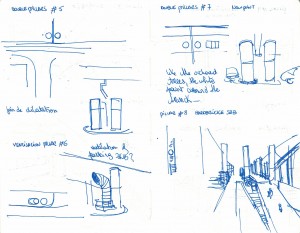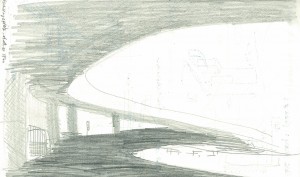“Everyone carries a shadow, and the less it is embodied in the individual’s conscious life, the blacker and denser it is.” C.G.Jung
The highway’s shadow- Zurich’s Hardbrücke
A high capacity infrastructure, the Hardbrücke is the main connection for north-south traffic over the city of Zurich. The freeway bridge is 1350 meters long, starting in Wipkingen, crossing the Limmat River to the railway station Hardbrücke SBB , spanning over the railway tracks towards the Hardplatz in the district of Albiesrieden. 70,000 vehicles use it everyday. This superstructure was constructed in the 1970’s as a provisional response to increased urban traffic. An object of controversy since its establishment , it is now a perennial construction, under renovation until 2011.
Its remarkable potential for public space lays in the fact that, almost entirely elevated on massive concrete pillars, it generates approximately 1,200 metres of covered space under its 4 traffic lanes, casting a long shadow on the city’s urban space. With 7,400 square meters of darkened nether-space, it is a fascinating element for research.
Beyond formal urban research, this examination of the Hardbrücke seeks to use an instrument of symbolic irony: the shadow theory, as in Jungian psychology . Part of the subconscious mind, the shadow represents weaknesses, shortcomings and instincts, an obvious parallel to the tensions generated by perimeters of infrastructure as well as by the urban organism itself. In terms of an urban study, the analogy of the human psyche to the city is intriguing as it allows one to investigate many logical parallels, and to form a hypothesis regarding infrastructural space from an empirical perspective. To illustrate this correlation, one can only underline the analytical terminology used by urban researchers and psychoanalysts alike.
Extended, this search leads to the conjecture that if this highway is the shadow of the city, representing its flaws and failures, would the implementation of a self-realized public space be the response to topple this situation and overcome the city’s ‘neurosis’? Currently hosting tram stations, copious parking spaces, pedestrian crossings, urban furniture and a railway station, some of disputable quality, the Hardbrücke is undergoing a process of renovation that will introduce new conditions of public space. Could this be the key to change its perception in the city’s collective and lead to the acceptance of its ‘shadow’, a solution recommended by psychoanalysts for their patients?-
The research has been published in « Infrastructure as Spatial Category/ Samples: Infrastructural spaces” by DOM publishers (Berlin).


